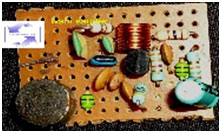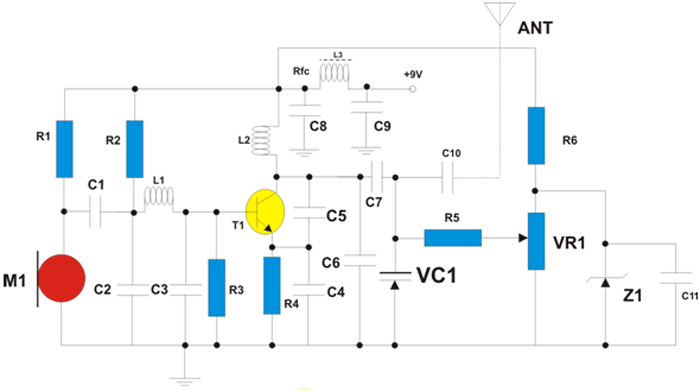The above circuit is a simple VHF FM transmitter circuit. It is basically a VHF colipits oscillator capable of transmitting sound or music to any standard FM receiver. The circuit works on a small 9V battery which makes it easily portable. It also has a capacitor microphone which picks up very weak sound signals. The output frequency can be easily changed by varying the potential meter and the frequency stability is quiet good. The range of this transmitter is 60 to 100meters.
The circuit works on a small 9V battery which makes it easily portable. It also has a capacitor microphone which picks up very weak sound signals. The output frequency can be easily changed by varying the potential meter and the frequency stability is quiet good. The range of this transmitter is 60 to 100meters.
 The circuit works on a small 9V battery which makes it easily portable. It also has a capacitor microphone which picks up very weak sound signals. The output frequency can be easily changed by varying the potential meter and the frequency stability is quiet good. The range of this transmitter is 60 to 100meters.
The circuit works on a small 9V battery which makes it easily portable. It also has a capacitor microphone which picks up very weak sound signals. The output frequency can be easily changed by varying the potential meter and the frequency stability is quiet good. The range of this transmitter is 60 to 100meters.Features:
•Electrically Adjustable frequency between 88 and 108MHZ.
• Portable and low power consumption.
• Use with any FM receiver.
• Powered by 9 Volt battery.
How It Works:
The transmitter uses the frequency modulation technique. So it evident that in Frequency Modulation, the amplitude of RF carrier stays constant while as frequency varies according to the intensity of the audio signal. As the input amplitude of signal increases (i.e. during the positive half cycles) the frequency of the carrier increases too, on the other hand when the input signal decreases in amplitude (negative half-cycle or no signal) the carrier frequency decreases accordingly. When we speak something through our mouth the sound waves, which are pressure waves, hits the diaphragm of the capacitor microphone which are converted into electrical signal. This electrical signal is fed to the transistor’s base which changes the output frequency of the transmitter. The output frequency of the transmitter is adjustable from 88 to 108 MHz under commercial FM band.
Circuit Description
The heart of the FM Transmitter circuit is a (VHF/UHF) oscillator transistor C1730 operates under class A .Resistors R2, R3 and R4 provides the necessary bias to the transistor for proper operation. Resistor R1 provides bias to the FET based capacitor microphone. Capacitor C1 is a coupling capacitor which couples the audio signal to the base of the transistor through L1.
L1 is an Rfc choke which chokes all high frequencies entering to the microphone. Capacitor C2 is a decoupling capacitor to high frequencies appearing at microphone. Capacitor C3 is RF ground to the transistor. The values of the tank elements (L2, C4, and C5 & C6) depend upon the chosen fundamental frequency.
2pif=1/root LCT
L=L2
CT=C4C5 /(C4+C5) II C6
Since C6 is chosen to limit the upper frequency which is a parallel component to C4 & C5. Therefore for higher frequency use it is recommended to decrease the value of L2. In the above circuit changing the value of C6 will also change the output frequency. Inductor L2 is an RF oscillator coil which is chosen to tune somewhere between 88 & 108MHZ band. Capacitor C8 and C9 is RF decoupling capacitor which prevents all Radio frequencies entering to power lines. Rfc L3 chokes out Radio frequencies. Capacitor C7 is a tuning capacitor. C10 is a coupling capacitor between Transmitter & antenna. VR-1 controls the voltage of varicap diode through RF isolating resistor R5. Resistor R6 and Zener diode Z1 is a 5V shunt voltage regulator, which regulates 5.1V to varicap diode, so as to minimize the frequency drift which may cause due to low or high input voltage. Capacitor C11 is used across Z1 to ensure a better RF isolation. Any type of 20 to 25cm telescopic antenna can be used. The range of this transmitter is 60 to 100mts.
Note..This is a VHF/RF project so more care is needed during soldering and Placement of all components. So keep all the leads/components as shortest as possible to minimize stray capacitance and inductance. The transmitter can be modified to any frequency between 50 & 400 MHz by replacing L2 & C6. It is strongly recommended to use a proper aluminum shielding above 150 MHZ to minimize the stray capacitances and inductance.
Parts List
Parts list:
R1= 10K
R2= 15K
R3= 3.3K
R4= 470 ohms
R5= 100K
R6= 4.7K
VR 1= 10K Pot meter
VALUE CAPACITOR CODE
C1= 0.1uF———————104
C2= 0.001uf——————-102
C3= 0.0015uF—————-152
C4= 10pf———————–10
C5= 3pf ————————3
C6= 2.5pf———————-2.5
C7= 10pf———————–10
C8= 0.01uF——————-103
C9= 0.022uF—————–223
C10= 1pf———————-1
C11= 0.001uf—————–102
Inductor
L1 & L3= 4.7uH Rfc color code= yellow, violet & silver as tolerance
L2= 5.5 turns close wound, SWG 23, internal dia of coil=5mm.
M1= CONDENSER MICROPHONE
T1= S9018 or 2SC1730 or 2SC1906 or any similar type having fT of 1.1 GHz
Z1= 5.1V, 500mW Zener diode
VC1= varicap diode BB109 or similar
Project Source Code
Circuit Diagrams
Filed Under: Electronic Projects



Questions related to this article?
👉Ask and discuss on EDAboard.com and Electro-Tech-Online.com forums.
Tell Us What You Think!!
You must be logged in to post a comment.